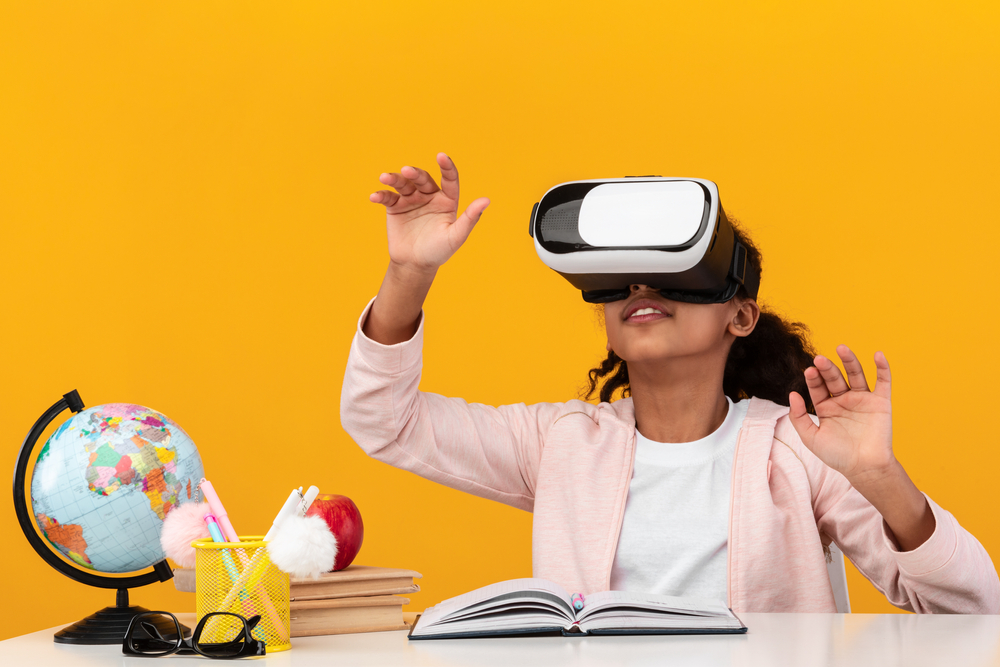The accelerated adoption of audio-visual equipment throughout UK classrooms looks set to continue to expand as educational institutions leverage technology to facilitate more enriched, personalised, and measurable learning outcomes catering to tech-dependent digital native students. While interactive flat panels and classroom control systems form the current cornerstones, emerging innovations loom on the horizon promising to further enhance and potentially revolutionise classroom environments and teaching methodologies.
More Immersive Learning Environments
Schools are beginning to explore augmented reality (AR) and virtual reality (VR) to transport lessons beyond four walls. VR headsets allow students to tour architectural wonders, explore space, practice medical procedures, or handle dangerous equipment safely through lifelike simulated training. AR overlays digital information onto real surroundings using recognition technology seen through phones and eventually projected directly into glasses. Students identify constellations by examining star maps overlaying night skies. Digital dinosaurs and ancient people appear to be interacting within school hallways and fields rooted in history. Hypothetical chemical reactions, fractures, or flow patterns materialise onto real items, manipulating perspectives dynamically. As costs fall and content libraries grow, AR and VR seem poised to spread rapidly.
Artificial Intelligence Integration
Expert artificial intelligence (AI) tutors are capable of natural voice conversation and support teaching by providing calibrated guidance, feedback, and assessments on demand tailored to individual strengths and weaknesses. AI chatbots answer basic student questions, freeing up teacher availability. They also monitor tasks, flagging potential problems like plagiarism or harmful content. As pattern recognition, machine learning, and predictive analytics functionalities improve, Al promises to amplify personalisation, productivity, and safety.
Advancing Collaborative Robots
Schools recognise the need to engage students in coding, automation, and robotics skills aligned to prominent technology-based careers. Thus programmable machines supporting computer science and engineering lessons proliferate. Sophisticated collaborative robots work alongside teachers and students, handling mundane tasks like wiping boards or distributing supplies, to allow more time to concentrate on high-value skills like developing creative solutions, designing custom programs, and constructing new prototypes. Some models feature charming humanised features and expressions, building emotional connections and aiding accessibility for those intimidated by cold machines. Denmark already mandates teaching robotics. As collaborative bots grow more affordable and intelligent while being simple to implement in classroom settings, adoption seems imminent.
3D Printing Labs
Schools actively establish dedicated 3D print labs filled with intuitive printers, design software, and raw printing materials that support project-based learning. Students attracted to hands-on building physical items from their own or shared digital plans gain visual and practical technology fluency beginning at junior levels. 3D printers build familiarity with key engineering and manufacturing concepts like computer-aided design (CAD), slicing, gcode, and more grounded in finished products. Print farms allow entire classes to prototype inventions in affordable biodegradable plastics, plant-based resins, and metals, readying concepts for economical short-run production via regional online fabrication services.
Analytics Advantage
Networked AV systems generate invaluable usage and performance analytics on every device, helping educators make smarter decisions and optimise investments for maximum measurable impact. Cloud-managed AV technology confirms what equipment and teaching methods students best respond to, guiding staff development and future procurement. Sophisticated software notes environmental factors like noise levels that hinder concentration, directing facility improvements. As analytics capabilities grow more sophisticated, classroom environments will evolve based firmly on empirical quantified data rather than assumptions or anecdotes.
The Next Generation of Learning
Education continues to embrace classroom technology that simplifies lesson delivery, inspires students, and enables data-driven customisation. The learning futures ahead promise more immersive multimedia, intelligent assistants, automation, and 3D creation, powering participatory experiences that were impossible just a few years ago. Savvy AV consultancy and integration will play a pivotal role in ensuring user-friendly solutions are designed around advancing educational goals rather than forcing environments to adapt around gadgets. Technology holds amazing potential to transform teaching and learning for the better when implemented thoughtfully. The coming innovations seem certain to accelerate this incredible journey even further in the coming years.



